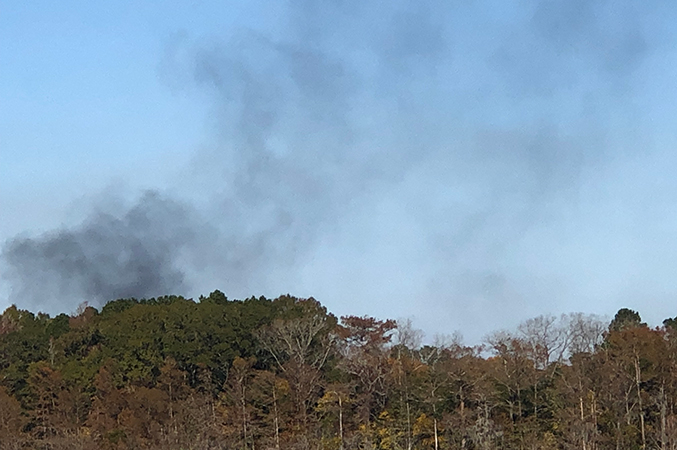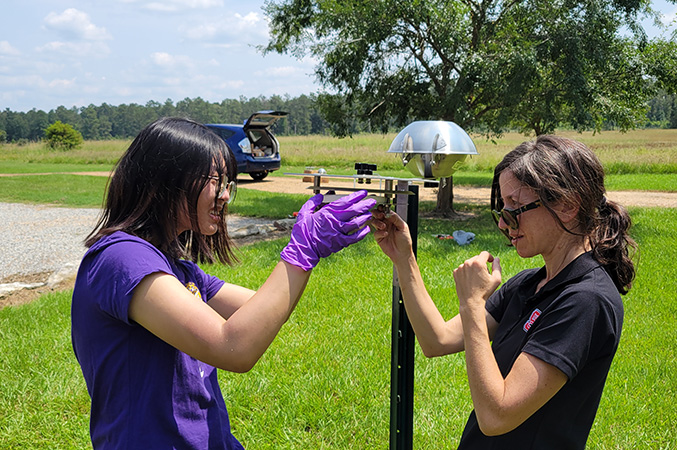Community stories about pollution were found to overlap the locations of a burn facility’s smoke plume, helping scientists improve their exposure assessment technique. Researchers at Louisiana State University, North Carolina State University, and Tulane University engaged with residents in Colfax, Louisiana, and local community partners to characterize the community’s concerns about exposure to environmental pollutants from a nearby commercial open burn/open detonation thermal hazardous waste treatment facility. The facility processes military ordnances, fireworks, propellants, and waste from Superfund sites.
A June 2022 paper describes how the researchers recorded oral histories with community members and mapped their locations. They then compared residents’ complaints to toxicological data showing a more complete picture of how contaminants spread geographically from the burn facility.
“In The Rock, a low-income enclave just south of the facility, we were able to visualize hot spots for symptoms related to health impacts to the thyroid, respiratory system, and skin, among other endpoints, as well as property damage,” stated Jennifer Richmond-Bryant, Ph.D., director of this Louisiana State University Superfund Research Program project and an associate professor at North Carolina State University. “Our results helped us to develop a proposal to the community for the locations for placing our environmental samplers as well as documenting the community members’ experiences.”
The red plus sign indicates the location of the burn facility, and red circles indicate 5-kilometer intervals. All dots indicate community members’ locations, while red dots indicate locations where respiratory disease was reported. The heat map of blue to yellow colors indicates concentration of respiratory disease cases, with yellow as the highest. (Image courtesy of Jennifer Richmond-Bryant)
Hearing from the Community
Colfax is a rural community in which a majority of residents are Black. The community experiences numerous disadvantages, including high unemployment, a large percentage of residents with less than a high school education, and a high percentage living below twice the poverty level. The burn facility sits approximately 5 miles north of the center of Colfax and a mile from The Rock enclave. Hazardous environmental exposures from this facility are an added burden, creating an environmental justice issue.
In 2018, the Louisiana Department of Environmental Quality (LDEQ) held a public hearing on the possible expansion of the burn facility, and 53 residents provided comments. To get more data, two community organizations reached out to the research team to measure pollution levels. The organizations were the Louisiana Environmental Action Network, a community-based not-for-profit organization that addresses environmental struggles in the state, and Central Louisiana Coalition for a Clean and Healthy Environment, a community organization started in 2016 to oppose the burning of hazardous waste at the facility. The research team then developed a sampling strategy and interviewed residents about their experiences.
The research team recruited interviewees through community partners and church pastors, and by choosing phone numbers at random from a phone book. University oral historian colleagues worked with the researchers to develop community-appropriate, open-ended interview questions.
Researchers conducted both in-person and phone interviews between January 2020 and January 2021. Residents shared details of the toll of living near the burn facility. Their comments were categorized according to the health, pollution, or property concern mentioned in the conversation.
In the article, one community member described the impact of the facility on her children: “The children can’t go out and play like they used to. They complain about scratching and itching and stuff like that, and stuff falling from the sky. You know it’s just big headaches, so [they] stay inside now.”

Smoke from the burn facility seen in the Colfax community. (Photo courtesy of Jennifer Richmond-Bryant)
Mapping Comments and Environmental Hazards Using Geographic Information Systems
Using geographic information software, researchers visualized the concentration of reported concerns by topic, such as respiratory problems, skin problems, home damage, or seeing smoke. Of the 65 community members who provided comments, with some participating in both the LDEQ meeting and the interviews, more than half described health problems, such as respiratory, skin, and thyroid issues. About half of the people noted hearing explosions or stated they had damage to their homes.
To determine whether the environmental hazards from the facility could reach the Colfax community, researchers used National Oceanographic and Atmospheric Administration software that accounts for weather and atmospheric conditions. The software allows researchers to model how contaminants would have spread through the air on the days for which LDEQ obtained burn data. The models indicated that contaminants from the burn facility likely reached the local Colfax community. Importantly, maps of residents’ health concerns overlapped with the exposure models. Furthermore, researchers used the PubChem database to determine that the materials burned at the facility are associated with many of the health concerns residents reported.
“Our modeling efforts validate residents’ narratives about the facility’s impact,” stated Richmond-Bryant. “Not surprisingly, hot spots from residents’ testimony about health effects line up with our plume models and with the known health effects of the compounds being burned at the facility. The residents’ oral histories are a critical foundational step for the work to make sure that we are locating our samplers and analyzing for compounds that will have the greatest impact on the community.”

Members of the research team set up an air quality monitoring device outside a Colfax resident’s home. (Photo courtesy of Jennifer Richmond-Bryant)
The research team hopes to gather additional evidence of the extent of hazardous exposures in the community, and in March 2022, they began to monitor the air quality outside several residents’ homes.
Brenda Vallee, lifelong Colfax resident and head of the Central Louisiana Coalition for a Clean and Healthy Environment, reflected on the impact of the exposure assessment so far: “Outside agencies have looked at the research and have asked questions. The research group responded and provided data.”
Source link
www.niehs.nih.gov

